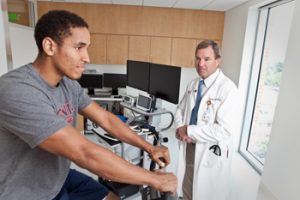Tell me about your program.
UVA sports cardiologist Robert Battle, MD, started this program. For close to 7 years now, he has been scanning first year athletes at UVA.
Division 1 athletes are the highest risk group for sudden cardiac arrest on the field. Out of those athletes, college football and basketball are highest risk sports.
Many other schools do a regular electrocardiogram (ECG) and physical when athletes begin a program. An ECG can come back normal and miss a lot of heart disease. We are one of handful of schools that do a full echocardiogram along with the ECG and physical..
Each year in the fall, our team works from 4:30-8:30pm on 4-5 nights completing the athlete screening. Our team includes Dr Battle, myself, nurses, and sonographers. The team screens every UVA athlete, from cheerleading to football to CavMan. We see about 150-200 athletes each year. We will also typically have another session in January to screen the transfer students.
If we find a problem at the screening or if an athlete has a problem while participating on the field, they come see Robert or myself for a sports cardiology visit. All checkups and testing are completed right in the Battle Building.
What have you learned that you’d want to share with others in the department?
We’ve learned the importance of doing the whole screening package together. These kids come in nervous and they don’t want to show it. To tell them their stats are normal across the board is a big relief for them and also hugely beneficial. Athletes can have different ECGs and echos than an average person. Typically we can reassure the athletes that they are normal. We tell them that they are a high-level athlete that can run a 4-minute mile. Their heart will look a little big which would be abnormal for a normal person but for a cross-country runner, it should look like that.
Sometimes we find little issues, but with our program and ability to follow the patients we can typically continue to allow them to continue to participate. If they have symptoms, we can get them in quickly, test quickly, and get them back to participating quickly.
We work with the trainer, as well. We have provided the trainers with monitors for their phones and they can monitor the athletes immediately.
Was there one story that really stood out for you along this process?
I remember a first year football player who was having chest pains and passed out on the practice field. I was able to see him the next day and was able to clear him to practice that afternoon. With the phone monitors, the trainers were able to confirm his heart was okay when the incident happened.
I also remember a cross-country runner who passed out at a meet. We had her run on the treadmill and completed a stress test. We confirmed it was not related to her heart and got her participating in the next meet.
What do you feel is the most exciting part of your program?
It is nice to be a part of this athlete team. With the occasional news story about an athlete dying while competing, it is nice to be able to see the athlete and the testing and reassure them that (to the best of our ability) they won’t have an event on the field. Sometimes it can benerve racking, but it is interesting to see the changes in the athletes hearts and to be able to allow athletes to continue their participation.
Anything else you’d like to add?
Robert and I are only one small piece of this program. We couldn’t do it without our support team. Special thanks to:
Pediatric cardiology fellow: Walter Hoyt
Sonographers: Christine Saunders, John Eagle, Michael Oien, and Hannah Knopp
Nurses: Adrienne Garo, Georgina King, Cari Luniewski, Maranacci Wilson, Whitney Wingfield, and Virginia Syptak
Filed Under: Features

